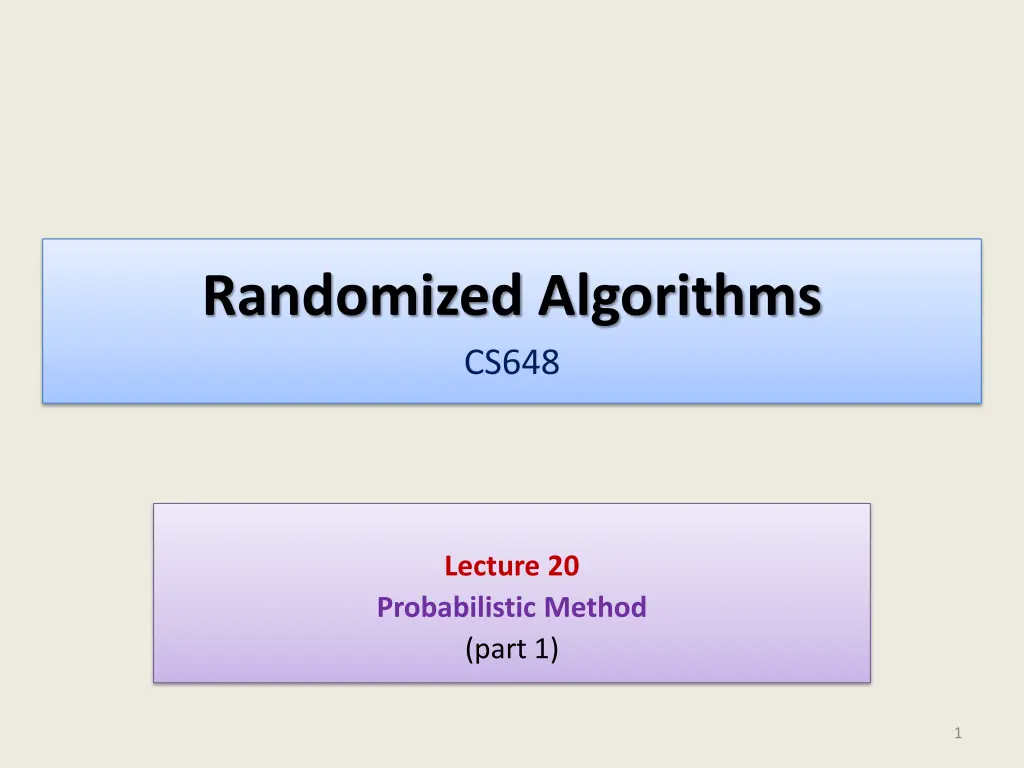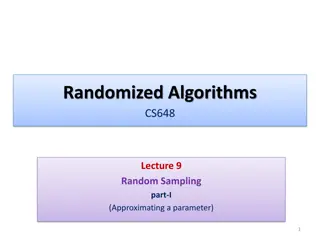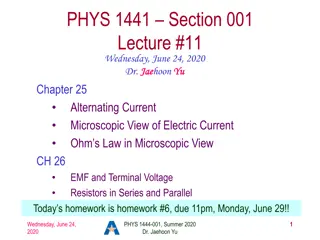
Probabilistic Methods in Randomized Algorithms: Exploring Min-Cuts and Acute Triangles
Explore the use of probabilistic methods in randomized algorithms by studying concepts like min-cuts and acute triangles. Understand how these methods leverage probability theory to achieve deterministic combinatorial results, and delve into the analysis and probabilities associated with these algorithms.
Uploaded on | 2 Views
Download Presentation

Please find below an Image/Link to download the presentation.
The content on the website is provided AS IS for your information and personal use only. It may not be sold, licensed, or shared on other websites without obtaining consent from the author. If you encounter any issues during the download, it is possible that the publisher has removed the file from their server.
You are allowed to download the files provided on this website for personal or commercial use, subject to the condition that they are used lawfully. All files are the property of their respective owners.
The content on the website is provided AS IS for your information and personal use only. It may not be sold, licensed, or shared on other websites without obtaining consent from the author.
E N D
Presentation Transcript
Randomized Algorithms CS648 Lecture 20 Probabilistic Method (part 1) 1
Probabilistic methods Methods that use Probability theory Randomized algorithm to prove deterministic combinatorial results 3
PROBLEM 1 HOW MANY MIN CUTS ? 4
Min-Cut ? = (?,?) : undirected connected graph Definition (cut): A subset ? ? whose removal disconnects the graph. Definition (min-cut): A cut of smallest size. Question: How many cuts can there be in a graph? Question: How many min-cuts can there be in a graph? ?? ? ? 5
Algorithm for min-cut Min-cut(?): { Repeat ? ? times { Let ? ??; ? Contract(?,?). } return the edges of multi-graph ?; } Running time: ?(??) Question: What is the sample space of the output of the algorithm ? Answer: all-cuts of ?. 6
Analysis of Algorithm for min-cut Let ?be any arbitrary min-cut. Question: What is probability that ? is preserved during the algorithm ? Answer: 1 ? ?. 1 ? ? ? 3 ? 5.2 4.1 ? ?. 1 3 ? ? ? ? ? ? ?. ? ? ? ? 3 5.2 4.1 . = 3 = ? ? ?. ? ? 7
Number of min-cuts Let there be ? min-cuts in ?. Let these min-cuts be ??,??, ,??. Define event ?: output of the algorithm Min-cut(?) is ?? . P( ?) ? ? ?(? ?) P( ? ?) ? P( ?)+P( ?)+...P( ?) = ? P( ?) = ? ? ?(? ?) Surely P( ? ?) 1 ?(? ?) ? ? 8
PROBLEM 2 HOW MANY ACUTE TRIANGLES ? 9
How many acute triangles Problem Definition: There is a set ? of ??? points in plane and no three of them are collinear. How many triangles formed by these points are acute ? Answer: At most ??% Solution: Let ? : probability that a triangle formed by 3 random points from ? is acute. Total number of acute triangles All possible triangles using? points Show that ? ?.? ? = 10
? points Case 1: Sum of the four angles is???. at least one of them has to be 90 Hence, at least one of the four triangles is non-acute. 11
? points Case 2: Sum of the three angles at the center is???. at least two of these angles have to be > 90 at least 2 of the four triangles is non-acute. 12
? points ? points Lemma1: A triangle formed by selecting 3 points randomly uniformly from 4 points is acute triangle with probability at most ?.??. Lemma2: A triangle formed by selecting 3 points randomly uniformly from 5 points is acute triangle with probability at most ?.?. (Do it as a simple exercise using Lemma 1.) 13
Two stage sampling ?: a set of ? elements. ? ? ? Let ? be a uniformly random sample of ? elements from ?. Let ? be a uniformly random sample of ? elements from ?. Question: What can we say about (probability distribution of) ? ? Answer: ? is a uniformly random sample of ? elements from ?. (Do it as a simple exercise. It uses elementary probability) Can you use this answer to calculate? ? 14
Number of acute triangles ?: set of ? points. ? : probability that a triangle formed by 3 random points from ? is acute. ? = ? ? : a uniformly random sample of ? points from ?. ? : a uniformly random sample of ? points from ?. ? = P(a random triangle from ? is acute) // use previous slide and elementary prob. ? ?.?? 15
PROBLEM 3 SUM FREE SUBSET OF LARGE SIZE 16
Large subset that is sum-free Problem Definition: There is a set ? of ? positive integers. Aim is to compute a large subset ? ? such that there do not exist three elements ?,?,? ? such that ? + ? = ? How large can ? be for any arbitrary ?? Answer: At least ?/? Spend some time to understand this problem and to realize its difficulty. 17
Large subset that is sum-free Let? > ? be a prime number. Let ? = ?? + ?. //The other choice ?? + ? is also fine here. A randomized algorithm: Select a random number ? from {1,? ?}. Map each element ? ? to ??mod?. ? all those elements of ? that get mapped to {? + ?, ,?? + ?} ? Return ?; Question: What is the expected number of elements from ? that are mapped to {? + ?, ,?? + ?} ? Answer: > ?/? To prove it, use the fact that mapping is 1-1 and uniform. and Linearity of expectation. 18
Large subset that is sum-free Let? > ? be a prime number. Let ? = ?? + ?. A randomized algorithm: Select a random number ? from {1,? ?}. Map each element ? ? to ??mod?. ? all those elements of ? that get mapped to {? + ?, ,?? + ?} ? Return ?; Claim: ? is sum-free. Try to prove it before going to the next slide 19
Showing that ? is sum-free. Let ? and ? be any two elements in ?. Let ? gets mapped to ? and ? gets mapped to ? and ?,? [? + ?,2? + ?] 1 2 ?? + ? ?? + ? 3? + ? ? ? Hence ? = ?? ??? ? and ? = ?? ??? ? we just need to show that ? + ? , if present in ?, must not be mapped in [? + ?,2? + ?]. ? + ? will be mapped to ?? Give suitable arguments to conclude that (? + ?) must be greater than 2? + ?. If(? + ?) > ?, then (? + ?)??? ? would be strictly less than ?. (? + ?)??? ? 20
Try to ponder over the entire solution given for the Large sum-free subset problem. Try to realize the importance of each part of the solution (primality of ?, the choice of middle third, ) This solution is one of those gems of discrete probability / randomized algorithm which you would like to revisit even after this course. I just wonder how such a great solution can come to one s mind 21
PROBLEM 4 LARGE CUT IN A GRAPH 22
Large cut in a graph Problem Definition: Let ? be an undirected graph on ? vertices and ? edges. How large can any cut in ? be ? Answer: At least ?/? Spend some time to find out a proof for this bound. Hopefully, after 3 problems, you would have realized the way probabilistic method works. 23
Large cut in a graph A randomized algorithm: ? ; Add each vertex from ? to ? randomly independently with probability ? ?. Return the cut defined by ?. 24
Large cut in a graph ?: size of cut (?, ?) returned by the randomized algorithm. E[?] = ?? ??: ? if ? is present in the cut ? otherwise ? = ??? E[?] = ??[??] = ??(??= ?) ? ? = ? =? ? 25
Large cut in a graph Now use the following result which is simple but very useful. Let ? is a random variable defined over a probability space (?,?). If ? ? = ?, then there exists an elementary event ? ?, such that ? ? ?. Use it to conclude that there is a cut of size at least ? ?. 26






















